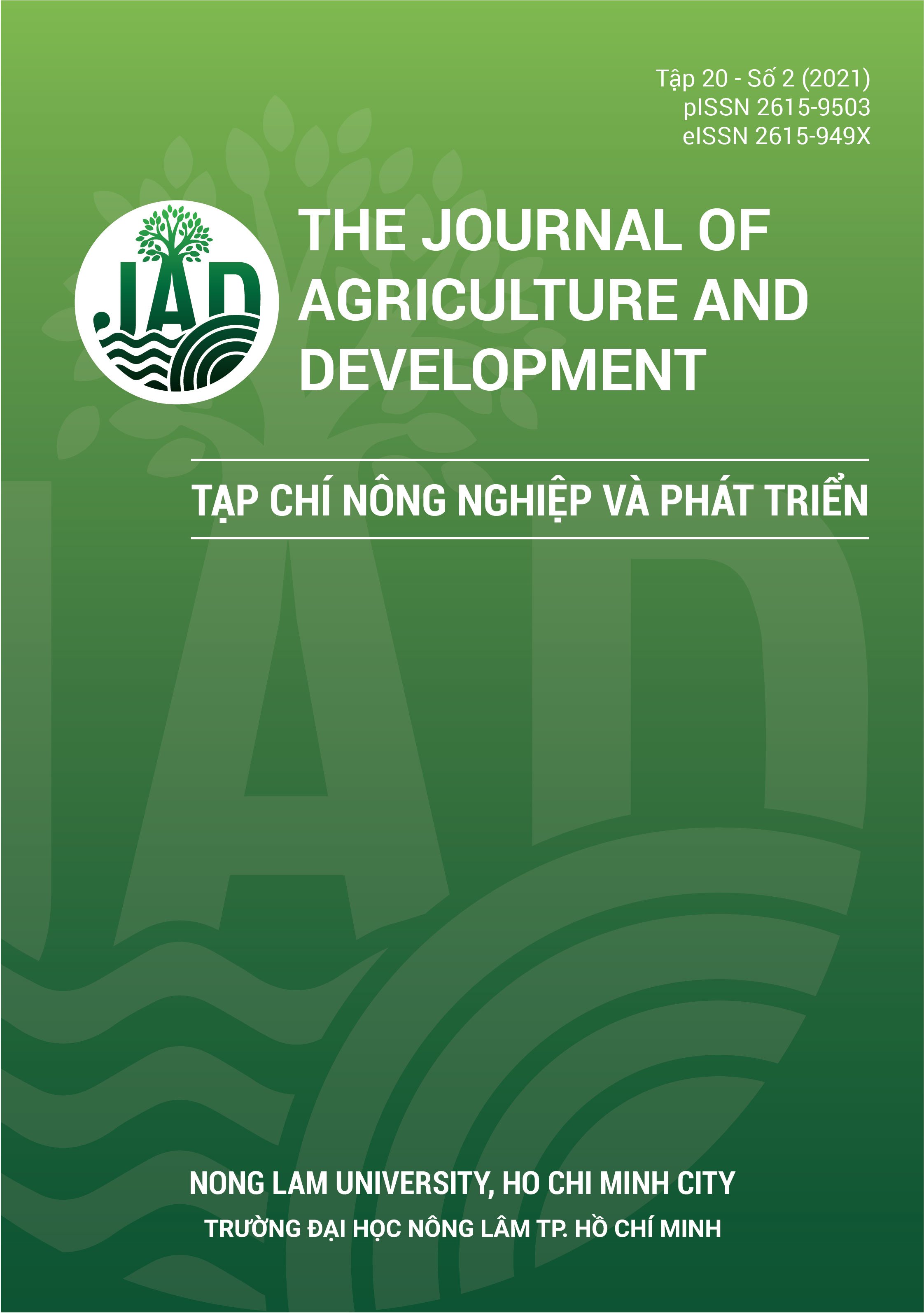Tối ưu hoá điều kiện trích ly flavonoids từ lá diếp cá
Main Article Content
Tóm tắt
Mục tiêu của nghiên cứu này nhằm sử dụng enzyme cellulase trong quá trình trích ly flavonoids từ lá diếp cá (Houttuynia cordata Thumb) và tối ưu hóa các yếu tố ảnh hưởng đến hiệu suất trích ly. Các thông số được khảo sát bao gồm: nồng độ enzyme (25 - 100➭g/mL), nhiệt độ (30 - 50oC), thời gian (30 - 120 phút) và tỉ lệ giữa nguyên liệu: enzyme (1:15 - 1:30 g/mL). Điều kiện trích ly flavonoids được tối ưu điều với thiết kế kiểu CCD (Central Composite Design) bằng phương pháp bề mặt đáp ứng, sử dụng phần mềm JMP Pro 13. Kết quả nghiên cứu đã xác định được điều kiện tối ưu trích ly flavonoids từ lá diếp cá, bao gồm nồng độ enzyme (78,0 ➭g/mL), nhiệt độ (41oC), thời gian (90 phút) và tỉ lệ nguyên liệu: enzyme (1:26 g/mL). Với điều kiện trích ly tối ưu này, hàm lượng flavonoid đạt được là 24,04 ± 0,05 mg/g, vật chất khô.
Article Details
Tài liệu tham khảo
Amin, N. A. S., & Anggoro, D. D. (2004). Optimization of direct conversion of methane to liquid fuels over cu loaded W/ZSM-5 catalyst. Fuel 83(4-5), 487-494. https://doi.org/10.1016/j.fuel.2003.09.013
Ba¸s, D., & Boyaci, I. H. (2007). Modeling and optimiza- tion i: usability of response surface methodology. Journal of Food Engineering 78(3), 836-845. https://doi.org/10.1016/j.jfoodeng.2005.11.024
Chang, J. S., Chiang, L. C., Chen, C. C., Liu, L. T., Wang, K. C., & Lin, C. C. (2001). Antileukemic Activity of Bidens pilosa L. var. Minor (Blume) Sherff and Houttuynia cordata Thunb. The American Journal of Chinese Medicine 29(02), 303-312. https://doi.org/10.1142/S0192415X01000320
Djihane, B., Wafa, N., Elkhamssa, S., Pedro, D. H. J., Maria, A. E., & Mohamed Mihoub, Z., (2017). Chemical constituents of Helichrysum italicum (Roth) G. Don essential oil and their antimicrobial activity against gram-positive and gram-negative bacteria, filamentous fungi and Candida albicans. Saudi Pharmaceutical Journal 25(5), 780-787. https://doi.org/10.1016/j.jsps.2016.11.001
Du, S., Li, H., Cui, Y., Yang, L., Wu, J., Huang, H., Chen, Y., Huang, W., Zhang, R., Yang, J., Chen, D., Li, Y., Zhang, S., Zhou, J., Wei, Z., & Chow, N. T. (2012). Houttuynia cordata inhibits lipopolysaccharide-induced rapid pulmonary fibrosis by up-regulating IFN-γ and inhibiting the TGF- β1/Smad pathway. International Immunopharmacology 13(3), 331-340. https://doi.org/10.1016/j.intimp.2012.03.011
Hahn, T., Lang, S., Ulber, R., & Muffler, K. (2012). Novel procedures for the extraction of fucoidan from brown algae. Process Biochemistry 47(12), 1691-1698. https://doi.org/10.1016/j.procbio.2012.06.016
Hoang, N. T. N., & Le, T. T. T. (2020). Study on the influence of cellulase enzyme and microwave on the ex- traction of Flucoidan from the seaweed Ceratophyllum Submersum. Journal of Science and Technology-The University of Danang 18(3), 5-9.
Kumar, M., Prasad, S. K., Krishnamurthy, S., & Hemalatha, S. (2014). Antihyperglycemic activity of Houttuynia cordata Thunb. in streptozotocin-induced diabetic rats. Advances in Pharmacological and Pharmaceutical Sciences 2014, 809438. https://doi.org/10.1155/2014/809438
Li, A. N., Li, S., Zhang, Y. J., Xu, X. R., Chen, Y. M., & Li, H. B. (2014). Resources and biological activities of natural polyphenols. Nutrients 6(12), 6020-6047. https://doi.org/10.3390/nu6126020
Li, T., Liu, L., Wu, H., Chen, S., Zhu, Q., Gao, H., Yu, X., Wang, Y., Su, W., Yao, X., & Peng, T. (2017). Anti-herpes simplex virus type 1 activity of Houttuynoid A, a flavonoid from Houttuynia cordata Thunb. Antiviral Research 144, 273-280. https://doi.org/10.1016/j.antiviral.2017.06.010
Meng, L., Lozano, Y., Bombarda, I., Gaydou, E., & Li, B. (2006). Anthocyanin and flavonoid production from Perilla frutescens: Pilot plant scale processing including cross-flow microfiltration and reverse osmosis. Journal of Agricultural and Food Chemistry 54(12), 4297-4303. https://doi.org/10.1021/jf0604079
Miyata, M., Koyama, T., & Yazawa, K. (2010). Water extract of Houttuynia cordata Thunb. Leaves exerts anti-obesity effects by inhibiting fatty acid and glycerol absorption. Journal of Nutritional Science and Vitaminology 56(2), 150-156. https://doi.org/10.3177/jnsv.56.150
Myers, R. H., & Montgomery, D. C. (2002). Response surface methodology: Product and process optimization using designed experiments (2nd ed.). New York, USA: John Wiley & Sons.
Puri, M, Sharma, D., & Barrow, C. J., (2012). Enzyme-assisted extraction of bioactives from plants. Trends in Biotechnology 30(1), 37-44. https://doi.org/10.1016/j.tibtech.2011.06.014
Sekita, Y., Murakami, K., Yumoto, H., Mizuguchi, H., Amoh, T., Ogino, S., Matsuo, T., Miyake, Y., Fukui, H., & Kashiwada, Y. (2016). Anti-bacterial and anti- inflammatory effects of ethanol extract from Houttuynia cordata poultice. Bioscience Biotechnology and Biochemistry 80(6), 1205-1213. https://doi.org/10.1080/09168451.2016.1151339
Truong, D. H., Le Q. P. T., Tran C. T. H., Pham, N. T. K., & Dong D. T. A. (2015). Optimization of extraction and extraction of crude saponins from Codonopsis Javanica (Blume) Hook. f. by alpha-amylase enzyme. Science and Technology Information Special 4(99), 1-3.
Vergara-Barberán, M., Lerma-García, M. J., Herrero- Martínez, J. M., & Simó-Alfonso, E. F. (2015). Use of an enzyme-assisted method to improve protein extraction from olive leaves. Food Chemistry 169, 28-33. https://doi.org/10.1016/j.foodchem.2014.07.116
Verma, R. S., Joshi, N., Padalia, R. C., Singh, V. R., Goswami, P., Kumar, A., Iqbal, H., Verma, R. K., Chanda, D., Chauhan, A., & Saikia, D. (2017). Chemical composition and allelopathic, antibacterial, anti- fungal, and antiacetylcholinesterase activity of fish-mint (Houttuynia cordata Thunb.) from India. Chemistry & Biodiversity 14(10), e1700189. https://doi.org/10.1002/cbdv.201700189
Wang, J. Y., Liu, Z. P., Liu, L., & Liu, C. (2008). Effects of NaCl on the growth and alkaloid content of Catharanthus roseus seedlings. The Journal of Applied Ecology 19(10), 2143-2148.








